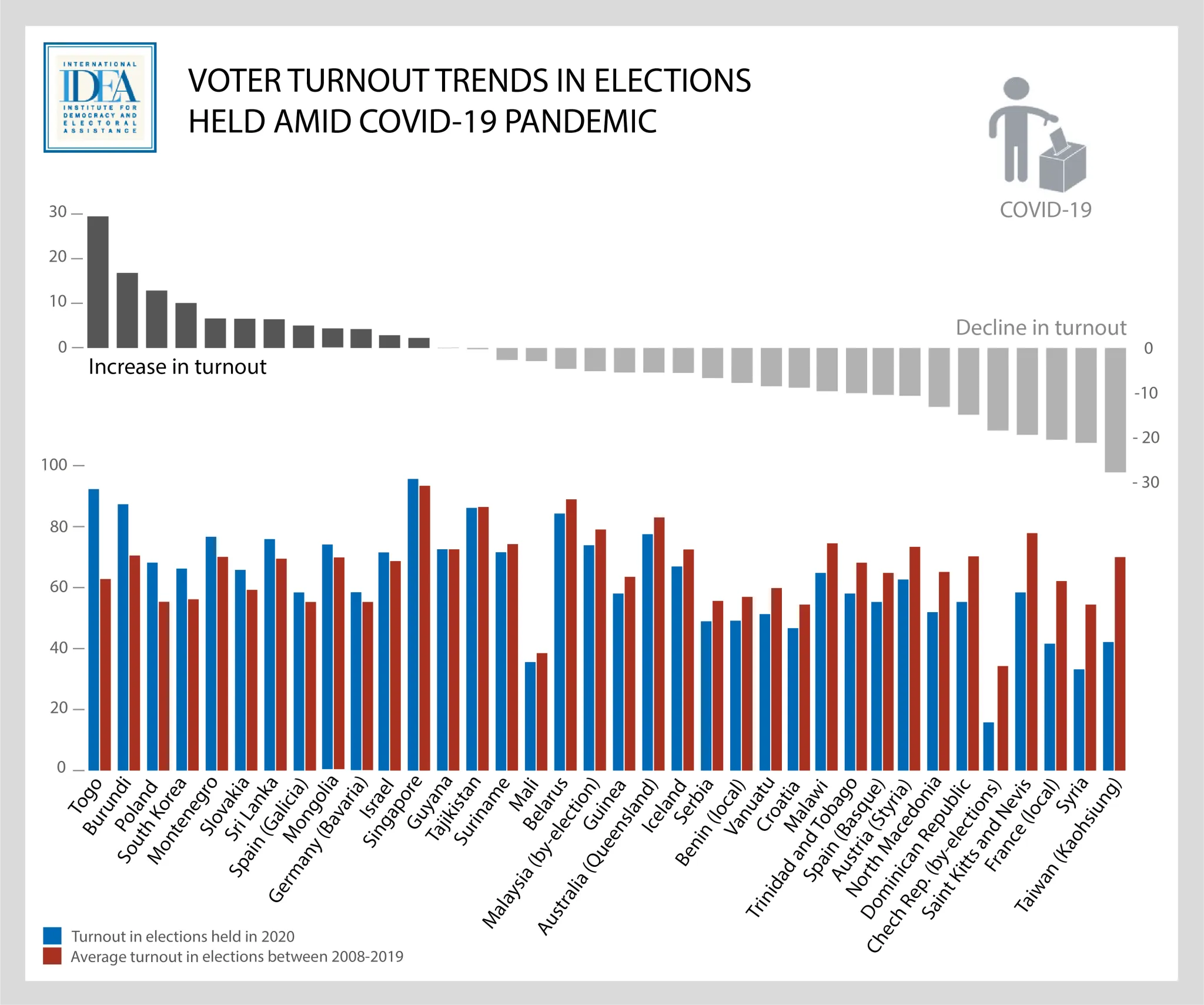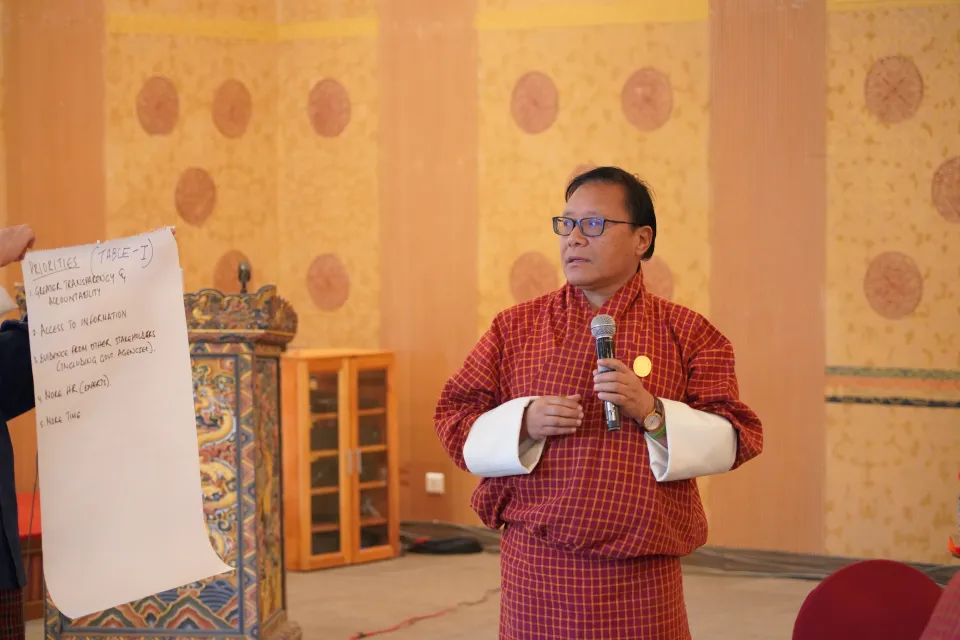Going against the trend: elections with increased voter turnout during the COVID-19 pandemic

As the COVID-19 pandemic is unfolding, with a second wave of infections already being experienced by various countries, a wide range of approaches are being taken by authorities to mitigate the public health impact, with an equally varied effects across the electoral cycle.
The tendency observed during the first months of the pandemic was for authorities to postpone elections. This was mainly due to numerous uncertainties regarding the possibility for completing the electoral cycle, while ensuring the health and safety of the people fulfilling different roles, in parallel with securing favourable conditions for inclusive, fair and transparent electoral processes. The trend has subsequently shifted as authorities have built a certain level or resilience, with a clear tendency towards holding elections.

Figure 2: Elections resuming gradually: Cumulative status of electoral processes impacted by Covid-19, Feb-August 2020.
The majority of the countries and territories that held elections since the crisis emerged saw a decline in turnout, raising concerns over the legitimacy of elections. However, Burundi, Germany (Bavaria), Israel, Mongolia, Montenegro, Poland, Singapore, Slovakia, South Korea, Spain (Galicia), Sri Lanka, Togo are countries that held elections amid the crisis and have seen an increase compared to the average turnout in their elections held beforehand between 2008 – 2019 (Figure 1).
The analysis, from more than 40 case studies developed by International IDEA, as part of the research on the Impact of COVID-19 on elections, identifies the factors that may have influenced the increase in turnout so far. A correlation exists between the implementation or scaled-up special voting arrangements (SVA), the political context and the timing of an election held.

Figure 3: Interactive map illustrating the impact of COVID-19 on elections worldwide
Source:
Special voting arrangements
The implementation of risk mitigation measures to contain the spread of the virus, including the use of SVAs, played an important role in most of the elections organized after the outbreak of COVID-19.
The SVAs were key elements that contributed to the, in some cases significant, increases in turnout. Postal voting, proxy voting, mobile ballot box voting, early voting have proven particularly important in many countries.
The voters in the German state of Bavaria had the possibility to choose between in-person voting and postal voting for the first round of local elections held on 16 March. As the risks related to COVID-19 increased, the authorities decided to switch to all-postal voting and made the necessary logistical arrangements during the two-week period between the first and second round. The measure resulted in an increase in turnout (59.5 per cent), including compared to the first round (58.8 per cent).
Even in other parts of Germany, SVAs were methods of participation that showed increases even if the overall turnout was lower, as it is the case in Lüdinghausen and Seppenradern. Similarly, in Austrian local elections in the province of Vorarlberg overall turnout decreased from 58.6 per cent in 2015 to 53.3 per cent in 2020, but the number of postal voters increased by 75 per cent compared to 2015.
South Korea’s success story as one of the first countries to organize national elections (April 2020) amid the COVID-19 pandemic has been widely documented and the lessons learned from its experience informed the measures implemented by other countries, such as Singapore, which also saw an increase in turnout.
SVAs will continue to play a significant role in future elections as the world is seeing new spikes in the number of infections, while countries and territories seem more willing to hold elections.
Political context
Poland and Montenegro are two more examples of countries where the turnout increased in 2020 elections compared to the average turnout between 2008 – 2019.
What both countries have in common and what arguably led to a high turnout is that both elections were deemed as crucial by the population in both countries and that the race in both elections were closely fought.
Burundi held presidential, legislative and local elections in May 2020 with few risk mitigation measures in place. Officially, only reported 42 infections with COVID-19 by the day of elections. While local officials repeatedly downplayed the risk posed by the novel coronavirus, all foreign electoral observers were requested by the local government to quarantine for 14 days. The turnout increased by approximately 14% compared to the previous elections.
Timing
Slovakia and Togo, two countries that held national elections in February 2020, only a few weeks after the Director-General of the World Health Organization (WHO) declared the outbreak of COVID-19 to be a Public Health Emergency of International Concern, saw an increase in turnout. However, there were no COVID-19 cases reported on the territory of the two countries at the time of elections, so there is a low probability that the risk of contagion influenced the decision to go to the polls for most of their citizens. No health and safety measures were implemented.
Israel held legislative elections on 2 March 2020, nine days before the WHO announced COVID-19 outbreak as a pandemic on 11 March 2020 and while the country had reported 12 infections with the novel coronavirus. The authorities established special polling stations and implemented specific measures for the 5630 people under home quarantine after returning from abroad. More than 72 per cent had voted by the time those polling stations were closed. Despite concerns related to voter fatigue (the third elections in less than one year), the overall national turnout was 71.5 per cent, higher than both the one registered in the previous legislative elections held in 2019 and the average turnout between 2008 and 2019.
More case studies as well as a catalogue with the latest analysis and publications by International IDEA experts on the impact of COVID-19 on elections worldwide are available here.






